小编给大家分享一下怎么运用springboot搭建并部署web项目,希望大家阅读完这篇文章之后都有所收获,下面让我们一起去探讨吧!
所用工具
IntelliJ IDEA 2018.1.4
JDK 1.8
apache-tomcat-8.0.50
所解决的问题
1、如何用idea创建springboot项目
2、如何进行 服务器、数据库、mybatis、视图解析器的配置
3、如何使用mybatis generator 自动生成代码
4、如何使用multipart进行文件上传
5、如何运用springboot的事务
6、如何打包进行tomcat部署
运用idea创建springboot项目
1、打开IDEA,File -> New -> Project,选择Spring Initializr,然后next。
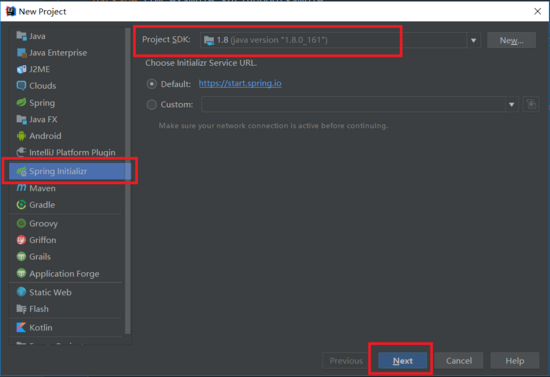
2、修改Ariifact,下面的Name、package会自动修改;Packaging有两种模式,一种是Jar,一种是War;因为springboot中自带了tomcat,因此可以将项目打成jar,直接运行;而我现有项目是部署到tomcat上,因此我需要打成war包;然后next。
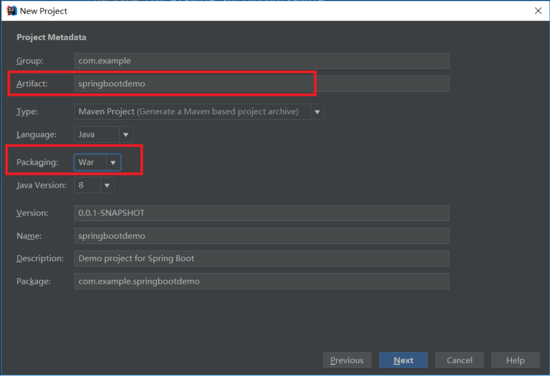
3、设置项目依赖,然后next ,进入下一页 ,设置project name,点击finish完成。
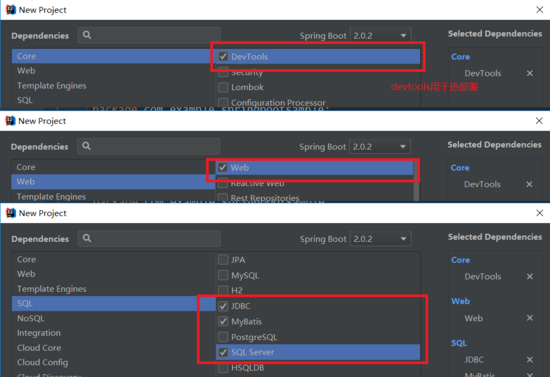
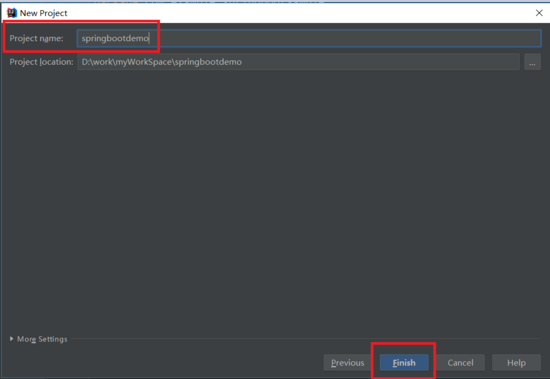
4、进入项目
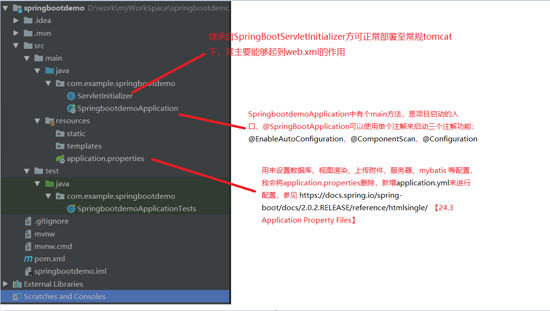
pom.xml
<?xml version="1.0" encoding="UTF-8"?> <project xmlns="http://maven.apache.org/POM/4.0.0" xmlns:xsi="http://www.w3.org/2001/XMLSchema-instance" xsi:schemaLocation="http://maven.apache.org/POM/4.0.0 http://maven.apache.org/xsd/maven-4.0.0.xsd"> <modelVersion>4.0.0</modelVersion> <groupId>com.example</groupId> <artifactId>springbootdemo</artifactId> <version>0.0.1-SNAPSHOT</version> <packaging>war</packaging> <name>springbootdemo</name> <description>Demo project for Spring Boot</description> <parent> <groupId>org.springframework.boot</groupId> <artifactId>spring-boot-starter-parent</artifactId> <version>2.0.2.RELEASE</version> <relativePath/> <!-- lookup parent from repository --> </parent> <properties> <project.build.sourceEncoding>UTF-8</project.build.sourceEncoding> <project.reporting.outputEncoding>UTF-8</project.reporting.outputEncoding> <java.version>1.8</java.version> </properties> <dependencies> <dependency> <groupId>org.springframework.boot</groupId> <artifactId>spring-boot-starter-jdbc</artifactId> </dependency> <dependency> <groupId>org.springframework.boot</groupId> <artifactId>spring-boot-starter-web</artifactId> </dependency> <dependency> <groupId>org.mybatis.spring.boot</groupId> <artifactId>mybatis-spring-boot-starter</artifactId> <version>1.3.2</version> </dependency> <dependency> <groupId>org.springframework.boot</groupId> <artifactId>spring-boot-devtools</artifactId> <scope>runtime</scope> </dependency> <dependency> <groupId>com.microsoft.sqlserver</groupId> <artifactId>mssql-jdbc</artifactId> <scope>runtime</scope> </dependency> <dependency> <groupId>org.springframework.boot</groupId> <artifactId>spring-boot-starter-tomcat</artifactId> <scope>provided</scope> </dependency> <dependency> <groupId>org.springframework.boot</groupId> <artifactId>spring-boot-starter-test</artifactId> <scope>test</scope> </dependency> </dependencies> <build> <plugins> <plugin> <groupId>org.springframework.boot</groupId> <artifactId>spring-boot-maven-plugin</artifactId> </plugin> </plugins> </build> </project>
无配置文件的springmvc
通过两个例子:1、http请求访问并渲染页面 2、http请求返回json字符串
-配置数据源、视图渲染
-添加视图渲染pom依赖
-创建WelcomeController、welcome.jsp
新增之后的项目结构
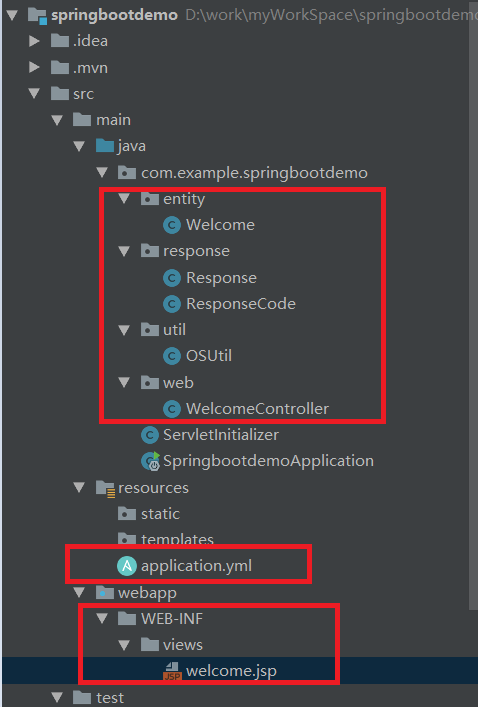
application.yml 配置数据源 和 视图渲染
# 数据源、视图配置 spring: datasource: url: jdbc:sqlserver://xx:1433;DatabaseName=xx username: xx password: xx driver-class-name: com.microsoft.sqlserver.jdbc.SQLServerDriver mvc: view: prefix: /WEB-INF/views/ suffix: .jsp
pom.xml新增视图渲染依赖
<!-- 使用 jsp 必要依赖 --> <dependency> <groupId>org.apache.tomcat.embed</groupId> <artifactId>tomcat-embed-jasper</artifactId> <scope>provided</scope> </dependency> <dependency> <groupId>javax.servlet</groupId> <artifactId>jstl</artifactId> </dependency>
创建WelcomeController
package com.example.springbootdemo.web;
import com.example.springbootdemo.entity.Welcome;
import com.example.springbootdemo.response.Response;
import com.example.springbootdemo.response.ResponseCode;
import org.springframework.stereotype.Controller;
import org.springframework.web.bind.annotation.RequestMapping;
import org.springframework.web.bind.annotation.ResponseBody;
import org.springframework.web.servlet.ModelAndView;
import java.util.ArrayList;
import java.util.List;
@Controller
@RequestMapping("/welcome")
public class WelcomeController {
/**
* 访问welcome.jsp页面
* @return
*/
@RequestMapping("welcomeIndex")
public ModelAndView welcomeIndex(){
ModelAndView mv = new ModelAndView();
mv.setViewName("welcome");
mv.addObject("name","xx");
return mv;
}
/**
* 返回json字符串
* @return
*/
@RequestMapping("getWelcomeInfo")
@ResponseBody
public Response getWelcomeInfo(){
/**
* 测试数据
*/
List<Welcome> welcomes = new ArrayList<>();
Welcome w1 = new Welcome();
w1.setId("1");
w1.setName("xx1");
w1.setAge(11);
w1.setGender("女");
Welcome w2 = new Welcome();
w2.setId("2");
w2.setName("xx2");
w2.setAge(22);
w2.setGender("男");
welcomes.add(w1);
welcomes.add(w2);
Response response = new Response();
response.setData(welcomes);
response.setRetcode(ResponseCode.SUCCESS);
response.setRetdesc("Success");
return response;
}
}创建welcome.jsp
<%@ page contentType="text/html;charset=UTF-8" language="java" %>
<html>
<head>
<title>视图渲染</title>
</head>
<body>
您好,${name}
</body>
</html>启动项目,并访问
http://localhost:8080/welcome/getWelcomeInfo
http://localhost:8080/welcome/welcomeIndex
使用mybatis generator自动生成代码
用于为表创建 *Mapper.xml、model、dao文件
在pom.xml 添加mybatis generator 自动生成代码插件
<build>
<plugins>
<plugin>
<groupId>org.springframework.boot</groupId>
<artifactId>spring-boot-maven-plugin</artifactId>
</plugin>
<!-- mybatis generator 自动生成代码插件 -->
<plugin>
<groupId>org.mybatis.generator</groupId>
<artifactId>mybatis-generator-maven-plugin</artifactId>
<version>1.3.2</version>
<configuration>
<configurationFile>${basedir}/src/main/resources/generator/generatorConfig.xml</configurationFile>
<overwrite>true</overwrite>
<verbose>true</verbose>
</configuration>
</plugin>
</plugins>
</build>在上面pom.xml配置的pugin路径resources/generator 文件夹下添加generatorConfig.xml
<?xml version="1.0" encoding="UTF-8"?> <!DOCTYPE generatorConfiguration PUBLIC "-//mybatis.org//DTD MyBatis Generator Configuration 1.0//EN" "http://mybatis.org/dtd/mybatis-generator-config_1_0.dtd"> <generatorConfiguration> <!-- 数据库驱动:选择你的本地硬盘上面的数据库驱动包--> <classPathEntry location="C:\Users\.m2\repository\com\microsoft\sqlserver\mssql-jdbc\6.2.2.jre8\mssql-jdbc-6.2.2.jre8.jar"/> <context id="DB2Tables" targetRuntime="MyBatis3"> <commentGenerator> <property name="suppressDate" value="true"/> <!-- 是否去除自动生成的注释 true:是 : false:否 --> <property name="suppressAllComments" value="true"/> </commentGenerator> <!--数据库链接URL,用户名、密码 --> <jdbcConnection driverClass="com.microsoft.sqlserver.jdbc.SQLServerDriver" connectionURL="jdbc:sqlserver://xx:1433;DatabaseName=xx" userId="xx" password="xx"> </jdbcConnection> <javaTypeResolver> <property name="forceBigDecimals" value="false"/> </javaTypeResolver> <!-- 生成模型的包名和位置--> <javaModelGenerator targetPackage="com.example.springbootdemo.entity" targetProject="src/main/java"> <property name="enableSubPackages" value="true"/> <property name="trimStrings" value="true"/> </javaModelGenerator> <!-- 生成映射文件的包名和位置--> <sqlMapGenerator targetPackage="mybatis" targetProject="src/main/resources"> <property name="enableSubPackages" value="true"/> </sqlMapGenerator> <!-- 生成DAO的包名和位置--> <javaClientGenerator type="XMLMAPPER" targetPackage="com.example.springbootdemo.mapper" targetProject="src/main/java"> <property name="enableSubPackages" value="true"/> </javaClientGenerator> <!-- 要生成的表 tableName是数据库中的表名或视图名 domainObjectName是实体类名--> <table tableName="xx" domainObjectName="StudentBinding" enableCountByExample="false" enableUpdateByExample="false" enableDeleteByExample="false" enableSelectByExample="false" selectByExampleQueryId="false"></table> </context> </generatorConfiguration>
使用maven中的mybatis-generator:generate根据数据库里面表生产相关的类
Edit Configurations -> 添加 -> Maven

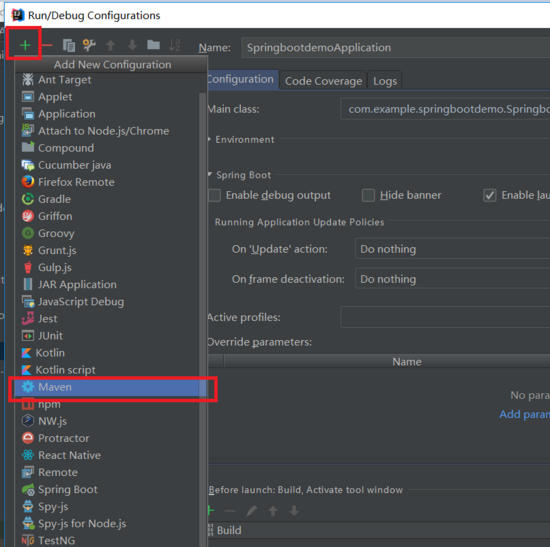
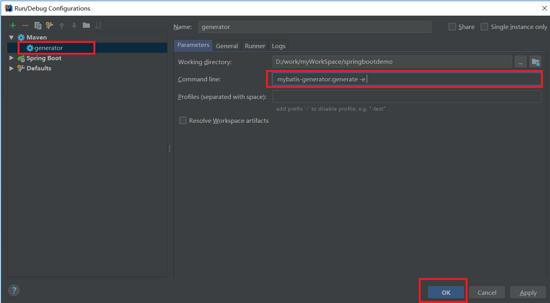

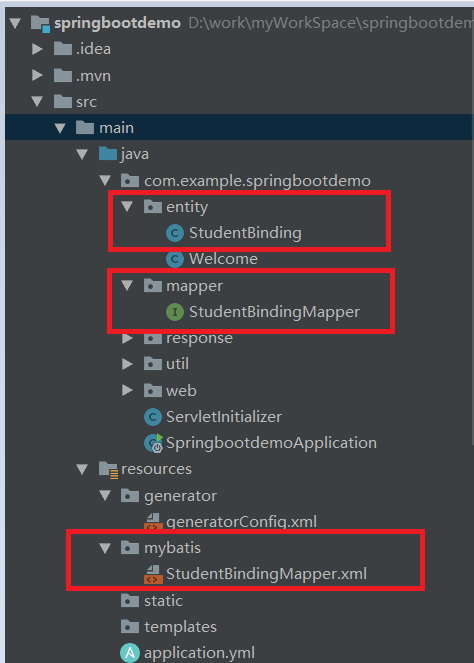
配置mybatis
在application.yml 中添加mybatis的配置
# mybatis配置 mybatis: mapper-locations: classpath*:mybatis/*Mapper.xml type-aliases-package: com.example.springbootdemo.entity
在StudentBindingMapper.java中添加 @Repository("studentBindingMapper")注解才能使用@MapperScan扫描到
@Repository("studentBindingMapper")
public interface StudentBindingMapper {}在SpringbootdemoApplication.java添加@MapperScan
package com.example.springbootdemo;
import org.mybatis.spring.annotation.MapperScan;
import org.springframework.boot.SpringApplication;
import org.springframework.boot.autoconfigure.SpringBootApplication;
@SpringBootApplication
@MapperScan("com.example.springbootdemo.mapper")
public class SpringbootdemoApplication {
public static void main(String[] args) {
SpringApplication.run(SpringbootdemoApplication.class, args);
}
}添加service、controller层
项目层级
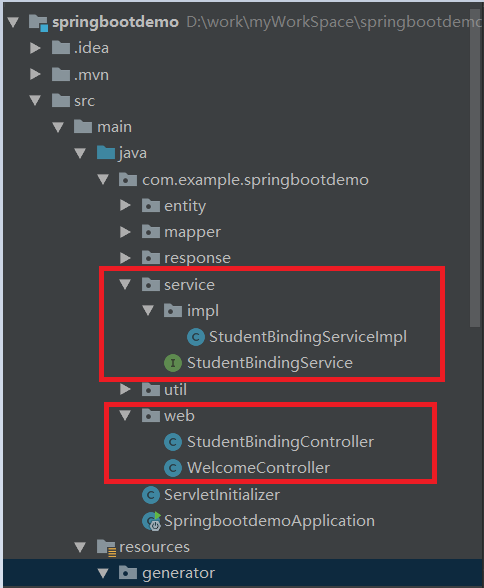
添加StudentBindingService
package com.example.springbootdemo.service;
import com.example.springbootdemo.entity.StudentBinding;
import java.util.List;
public interface StudentBindingService {
int deleteByPrimaryKey(Long id);
int insert(StudentBinding record);
int insertSelective(StudentBinding record);
StudentBinding selectByPrimaryKey(Long id);
int updateByPrimaryKeySelective(StudentBinding record);
int updateByPrimaryKey(StudentBinding record);
void validTransaction(Long id);
List<StudentBinding> getStudentBindByQuery(StudentBinding record);
}添加StudentBindingServiceImpl
package com.example.springbootdemo.service.impl;
import com.example.springbootdemo.entity.StudentBinding;
import com.example.springbootdemo.mapper.StudentBindingMapper;
import com.example.springbootdemo.service.StudentBindingService;
import org.springframework.beans.factory.annotation.Autowired;
import org.springframework.stereotype.Service;
import org.springframework.transaction.annotation.Transactional;
import java.util.List;
@Service(value = "studentBindingService")
public class StudentBindingServiceImpl implements StudentBindingService {
@Autowired
private StudentBindingMapper studentBindingMapper;
@Override
public int deleteByPrimaryKey(Long id) {
return studentBindingMapper.deleteByPrimaryKey(id);
}
@Override
public int insert(StudentBinding record) {
return studentBindingMapper.insert(record);
}
@Override
public int insertSelective(StudentBinding record) {
return studentBindingMapper.insertSelective(record);
}
@Override
public StudentBinding selectByPrimaryKey(Long id) {
return studentBindingMapper.selectByPrimaryKey(id);
}
@Override
public int updateByPrimaryKeySelective(StudentBinding record) {
return studentBindingMapper.updateByPrimaryKeySelective(record);
}
@Override
public int updateByPrimaryKey(StudentBinding record) {
return studentBindingMapper.updateByPrimaryKey(record);
}
@Override
@Transactional
public void validTransaction(Long id){
// 删除之后,插入该id的数据
studentBindingMapper.deleteByPrimaryKey(id);
StudentBinding record = new StudentBinding();
record.setId(id);
studentBindingMapper.insertSelective(record);
}
@Override
public List<StudentBinding> getStudentBindByQuery(StudentBinding record) {
return studentBindingMapper.getStudentBindByQuery(record);
}
}新增StudentBindingController
package com.example.springbootdemo.web;
import com.example.springbootdemo.entity.StudentBinding;
import com.example.springbootdemo.response.Response;
import com.example.springbootdemo.response.ResponseCode;
import com.example.springbootdemo.service.StudentBindingService;
import org.springframework.beans.factory.annotation.Autowired;
import org.springframework.stereotype.Controller;
import org.springframework.web.bind.annotation.RequestMapping;
import org.springframework.web.bind.annotation.RequestParam;
import org.springframework.web.bind.annotation.ResponseBody;
import org.springframework.web.multipart.MultipartFile;
import org.springframework.web.servlet.ModelAndView;
import java.io.File;
import java.io.IOException;
import java.util.List;
@Controller
@RequestMapping(value = "/studentBind")
public class StudentBindingController {
@Autowired
private StudentBindingService studentBindingService;
/**
* 根据请求参数,删除绑定学生信息
* @param id
* @return
*/
@RequestMapping("deleteByPrimaryKey")
@ResponseBody
public Response deleteByPrimaryKey(Long id){
Response response = new Response();
if(id==null){
response.setRetcode(ResponseCode.PARAMARTER_ERROR);
response.setRetdesc("参数错误");
return response;
}
try{
studentBindingService.deleteByPrimaryKey(id);
response.setRetcode(ResponseCode.SUCCESS);
response.setRetdesc("删除成功");
}catch (Exception e){
e.printStackTrace();
response.setRetcode(ResponseCode.FAILED);
response.setRetdesc("删除异常");
}
return response;
}
/**
* 根据请求参数,添加绑定学生信息
* @param record
* @return
*/
@RequestMapping("insertSelective")
@ResponseBody
public Response insertSelective(StudentBinding record){
Response response = new Response();
if(record==null){
response.setRetcode(ResponseCode.PARAMARTER_ERROR);
response.setRetdesc("参数错误");
return response;
}
try{
studentBindingService.insertSelective(record);
response.setRetcode(ResponseCode.SUCCESS);
response.setRetdesc("添加成功");
}catch (Exception e){
e.printStackTrace();
response.setRetcode(ResponseCode.FAILED);
response.setRetdesc("添加异常");
}
return response;
}
/**
* 根据请求参数,查询绑定学生信息
* @param id
* @return
*/
@RequestMapping("selectByPrimaryKey")
@ResponseBody
public Response selectByPrimaryKey(Long id){
Response response = new Response();
if(id==null){
response.setRetcode(ResponseCode.PARAMARTER_ERROR);
response.setRetdesc("参数错误");
return response;
}
try{
StudentBinding studentBinding = studentBindingService.selectByPrimaryKey(id);
response.setData(studentBinding);
response.setRetcode(ResponseCode.SUCCESS);
response.setRetdesc("查询成功");
}catch (Exception e){
e.printStackTrace();
response.setRetcode(ResponseCode.FAILED);
response.setRetdesc("查询异常");
}
return response;
}
/**
* 验证@Transaction注解是否好用
* @param id
* @return
*/
@RequestMapping("validTransaction")
@ResponseBody
public Response validTransaction(Long id){
Response response = new Response();
if(id==null){
response.setRetcode(ResponseCode.PARAMARTER_ERROR);
response.setRetdesc("参数错误");
return response;
}
try{
studentBindingService.validTransaction(id);
response.setRetcode(ResponseCode.SUCCESS);
}catch (Exception e){
e.printStackTrace();
response.setRetcode(ResponseCode.FAILED);
}
return response;
}
/**
* 渲染jsp页面
* @return
*/
@RequestMapping("welcomeIndex")
public ModelAndView welcomeIndex(){
List<StudentBinding> studentBindings = studentBindingService.getStudentBindByQuery(new StudentBinding());
// model.addAttribute("studentBindings",studentBindings);
ModelAndView mv = new ModelAndView();
mv.setViewName("welcome");
mv.addObject("studentBindings",studentBindings);
return mv;
}
/**
* 跳转到上传文件页面
* @return
*/
@RequestMapping("multipartIndex")
public String multipartIndex(){
return "multipart-index";
}
/**
* 上传文件到指定目录
* @param file
* @return
*/
@RequestMapping("/upload")
@ResponseBody
public Response upload(@RequestParam("file") MultipartFile file){
Response response = new Response();
if (file.isEmpty()){
response.setRetcode(ResponseCode.PARAMARTER_ERROR);
response.setRetdesc("参数错误");
return response;
}
try {
String filePath = "D:\\ceshi\\upload\\";
File dir = new File(filePath);
if(!dir.isDirectory()){
dir.mkdir();
}
String fileOriginalName = file.getOriginalFilename();
File writeFile = new File(filePath + fileOriginalName);
//文件写入磁盘
file.transferTo(writeFile);
response.setRetcode(ResponseCode.SUCCESS);
response.setRetdesc("上传成功");
} catch (IOException e) {
e.printStackTrace();
response.setRetcode(ResponseCode.FAILED);
response.setRetdesc("上传失败");
}
return response;
}
}重启项目之后,就可以访问各个接口
springboot配置事务
springboot配置事务有两种方式
1、在SpringbootdemoApplication.java项目入口,添加@EnableTransactionManagement的注解用来开启事务
2、在service实现类上添加@Transactional注解,那么该类的所有方法都进行事务管理;也可以直接在service实现类的方法上直接添加@Transactional注解,那么只对该方法进行事务管理,上面代码中有对方法添加事务的例子
springboot打包进行tomcat部署
Edit Configuration -> Maven -> 添加 ->启动 -> 复制war包 -> tomcat webapp ->修改war包的名字 -> tomcat bin -> startup.bat

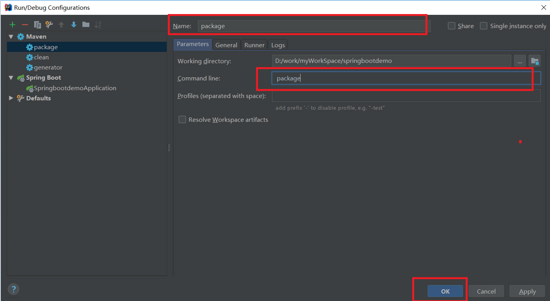

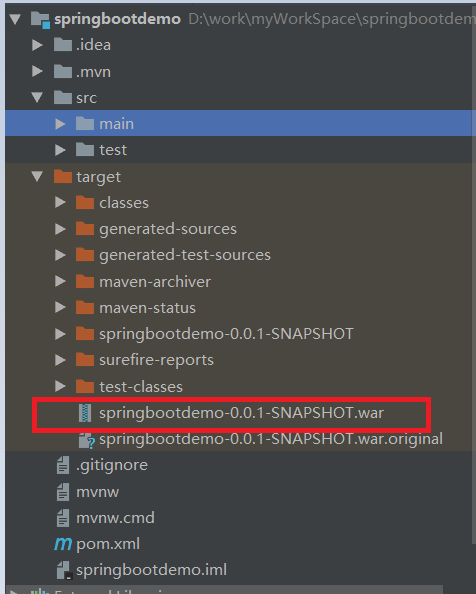
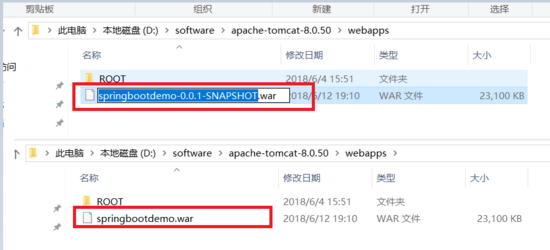
tomcat启动之后,访问 http://localhost:8080/springbootdemo/welcome/welcomeIndex 进行验证

看完了这篇文章,相信你对“怎么运用springboot搭建并部署web项目”有了一定的了解,如果想了解更多相关知识,欢迎关注亿速云行业资讯频道,感谢各位的阅读!
免责声明:本站发布的内容(图片、视频和文字)以原创、转载和分享为主,文章观点不代表本网站立场,如果涉及侵权请联系站长邮箱:is@yisu.com进行举报,并提供相关证据,一经查实,将立刻删除涉嫌侵权内容。